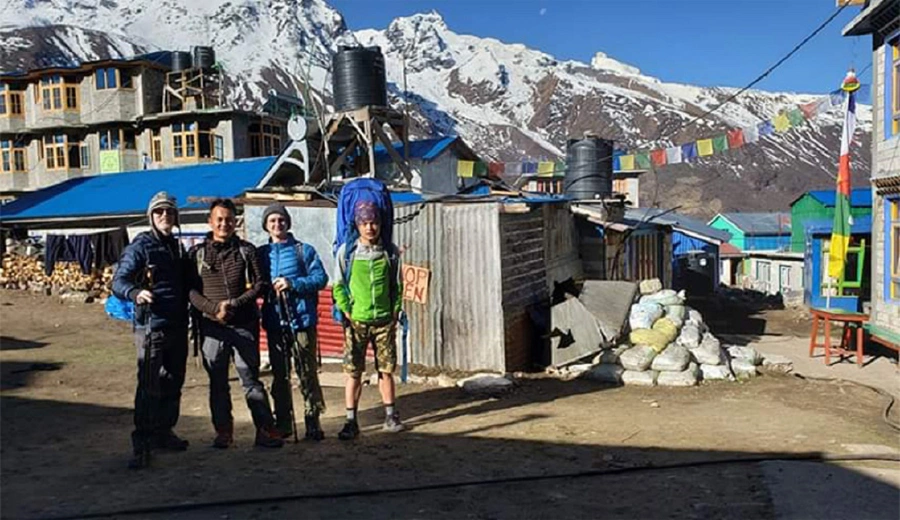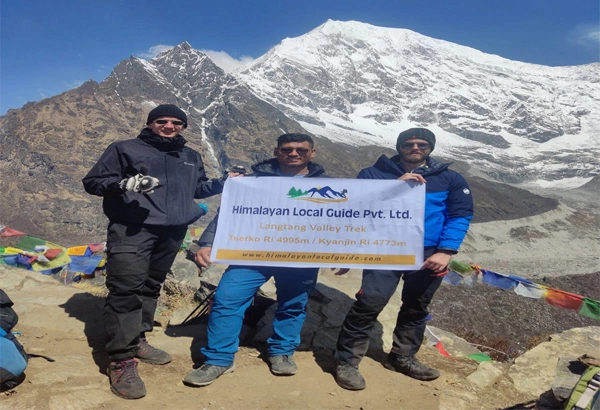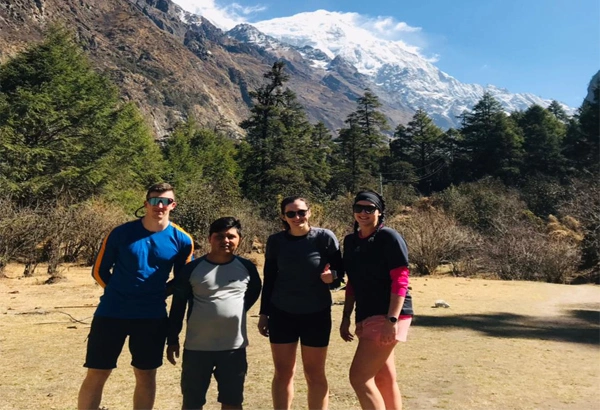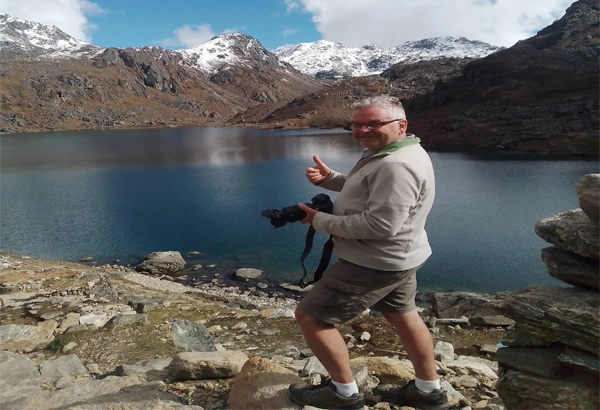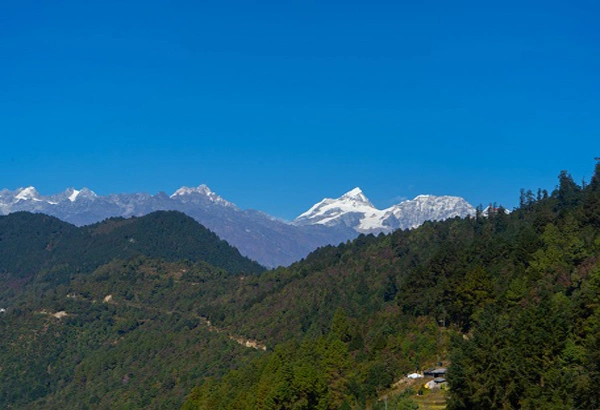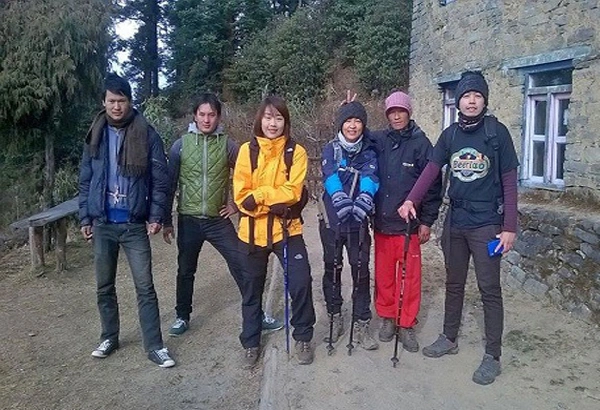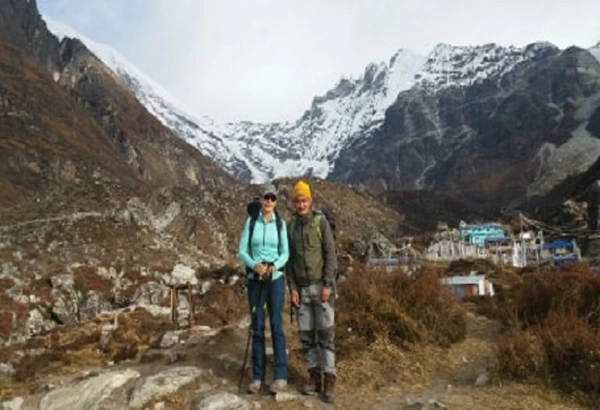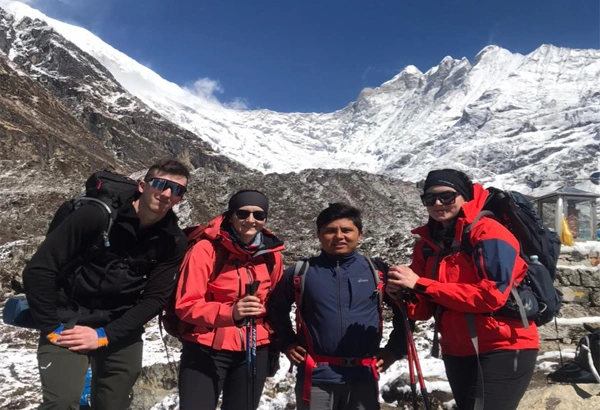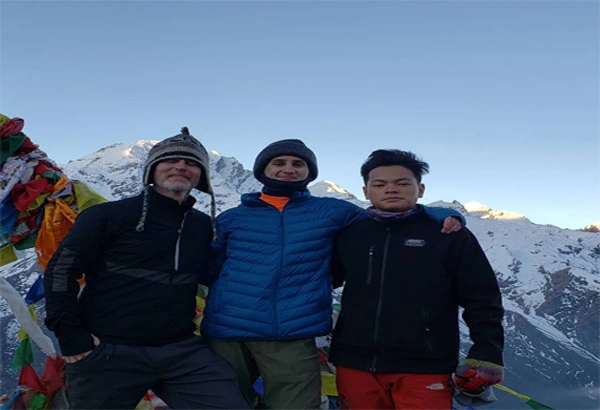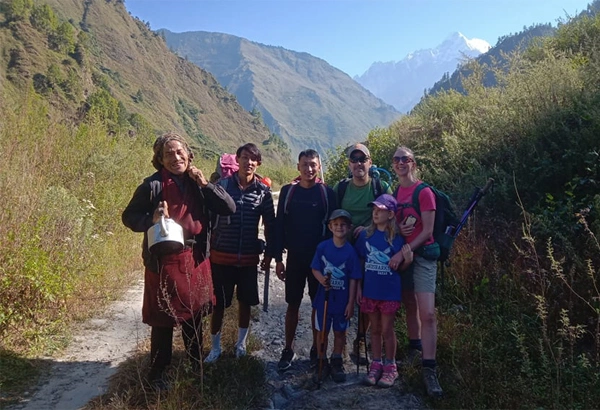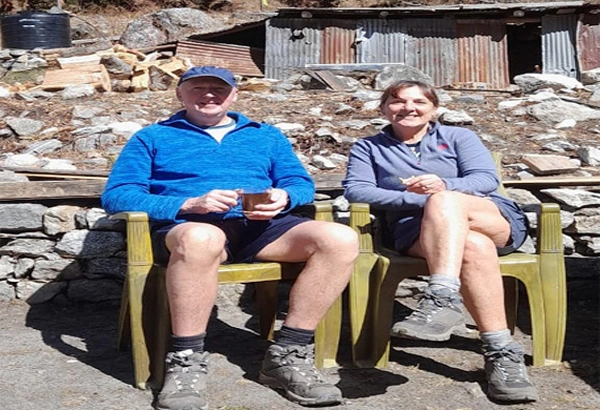Trip Highlights
- Tamang and Tibetan ethnicity, culture, and village.
- Buddhist monasteries at Kyanjin Gompa.
- Cheese factory at Kyanjin Gompa.
- Magical Vista likes Langtang Lirung, Yala Peak, Dorje Lakpa, and many more.
- Crossing Beautiful Bhote Koshi River and Langtang Valley Khola.
- Delightful village passes like Bamboo, lama hotel, Langtang, and Khyanjin Gompa.
- Langtang National Park has wild Animals like monkeys, Red pandas, mountain Goats, and many more.
- An earthquake damaged Langtang Village.
- Sunrise view from Khynjing Ri (4773 meters) or Tserko Ri (4993 meters).
- Visit to Langsisha kharka.
Detail About Langtang Valley Trek Solo
Are you a solo trekker?
The Nepal Government has decided that trekking in Nepal is not allowed without a Guide from 1st April 2023. If you are a solo trekker, do not worry. We will arrange the Best Guide and Porter team after you can make this trip easily.
Langtang Valley Trek is the most popular trekking trail in the Nepal Himalayan region. The Himalayan local guide is proud to present; the Langtang Valley short trip itinerary. The trail 8 - Days Langtang Valley Trek Solo starts with a bus drive of 7/8 Hrs from Kathmandu City to Shyabrubesi. Trek will start at Syabrubesi Town, cross Bhote Koshi River, Old Shyabrubesi, and follow the Langtang Valley Khola while passing a beautiful green Lush forest with pine and Rhododendron trees.
Langtang Valley trekking will be snowed under by the vista of Langtang II, Langtang Lirung 7234m, Langshisha 6820m, Dorje Lakpa 6966m, Nayakang Peak, Yala Peak 5520m, waterfalls and Lots of Rocky Hills. If you are lucky, you may see Red Pandas, white Monkeys, snow Leopards, Mountain Goats, etc. And During February, March, and April. The surroundings become more beautiful because of the color of the National flowers of rhododendron forests. Trekkers will get damaged by a big earthquake around 7.8 rector magnitudes Langtang Lirung glacier landslide when they reach Langtang Village. You can see the Memorials of how many Local people died and Even Trekkers. Trekking will be a short hike from Langtang village to Kyanjin Gompa. The village of Kyanjin Gompa is typically colorful and has a sightseeing cheese factory and ancient Buddhist Gompa.
Early in the morning climb up to Kyanjin Ri 4780m or Tserko Ri (4995m). Its main viewpoint of all Himalayan ranges and sunrise view back to the Hotel, and finally return to Lama Hotel and Shyabrubesi and drive back to Kathmandu.
The Solo Langtang Valley trek is a short holiday to do in Nepal trekking. Book with us for your short vacation in Nepal Himalayan region, (NEPAL) N - Never E - Ending P - Peace A - And L - Love.
Why Solo Langtang Valley Trek With Us?
- Himalayan Local Guide Pvt. Ltd. has years of experience in this field. As a consequence, our local trekking Guide knows what customers can expect, and they have never been unsuccessful in the client opportunity. You may check what our previous customers say about us on our trip advisor and Review page.
- We organize professional local trekking guides and porters service for Nepal Trekking & Peak Climbing in the Himalayas region of Annapurna, Everest, Langtang, Ganesh Himal, Mustang, Manaslu, Kanchenjunga, Dolpo, and many more places, etc.
- Himalayan Local Guide Team. Put the safety and the security of the clients as their foremost priority. For them, customer pleasure is everything. So they work very hard to ensure clients are having the best time. While in Nepal Himalayas regions.
- Our Professional Local trekking Guides are educated and speak many different kinds of languages; and well-known English. The Guides are trusty trained Government License holders; the porters are too Strong from the high altitude Mountains.
How hard is the Langtang Trek route?
This trip is Nepal’s preferred trekking destination in the Himalayas; it is a moderate trek in the Langtang National Park region. Most travelers/trekkers in good health and reasonable physical fitness will complete this itinerary without concern, and no previous trekking experience is required. However, this trip reaches elevations higher than 4,000 meters. It is most important to drink a lot of water and get plenty of rest to let your body adjust naturally to the increased altitude. As always, your local trekking guide will take care of your adjustment and make sure that you take pleasure in a safe and rewarding trek to Langtang Valley Himalayas.
We are providing, if you are looking for a better challenge or; if you would like to spend a few more days in the Nepal Himalayas, Himalayan Local Guide Pvt. Ltd is conceited to present a host of alternative routes for you. Travelers/Trekkers extra time to additional will find our Trip packages to Langtang Valley Trek, Langtang Gosaikunda Short Trek, Tamang Heritage Trail Trek, and Langtang Gosaikunda Helambu Trek.
Trip Itinerary Expand All
- Walking Distance 122 Km / 75.8 Miles
- Maximum Height 1462 Meters
- Accommodation Hotel/Lodge/Tea House
After an early morning breakfast, we will start our scenic drive from Kathmandu to Syabrubesi by local bus sharing with other peoples. It takes around 7/8 hours; reach to Syabrubesi after then we will stay overnight at Lodge.
- Day Meals Breakfast/Lunch & Dinner
- Walking Distance 10.9 Km/6.7 Miles
- Maximum Height 2450 Meters
- Accommodation Hotel/Lodge/Tea House
Today is our first day journey, for the trip route, we will cross the Bhote Koshi River and Langtang valley Khola after then we will follow the langtang valley khola river side through the lush green forest and terraced fields. We passing the delightful landscape, pine and rhododendron forest, hills, waterfalls, we trek continue to ascending and descending reach to Pairo, this place has two hotel we can have just few hours to break and having tea, again we will climb to dense forest, chance to see the including; Monkeys, Read panda, Musk deer, and many different kinds of wilds birds, we will enjoy with nature jungle, wilds animals then we continue to reach the Bamboo. Where we will have lunch break at there, after finish the delicious lunch, we will climb uphill to cross the suspension bridge, climbing steeply reach to Rimche Danda from here, we will have to walk reach to Lama Hotel it will takes around 10 to 15 minutes, overnight at Lodge.
- Day Meals Breakfast/Lunch & Dinner
- Walking Distance 14.8 Km / 9.1 Miles
- Maximum Height 3560 Meters
- Accommodation Hotel/Lodge/Tea House
Today we will continue to walk along the river side through a lush green landscape aw we uphill through the pine and rhododendron forests. On the way, we will be able to see the white snow-capped peaks beckoning us forward. Finally, the narrow langtang River valley widens out at Ghoda Tabela, where the small restaurant at there for lunch and tea break place. After we trek continue to passing the Thangshep village and reach to Langtang Village overnight at Lodge.
- Day Meals Breakfast/Lunch & Dinner
- Walking Distance 6.8Km / 4.2 Miles
- Maximum Height 3870 Meters
- Accommodation Hotel/Lodge/Tea House
Today will be our short and exciting day, after the breakfasts we trek continue to our gradual ascent as we passes through the small deserted village and meadows. This valley offers the an amazing panoramic mountains view of Langtnag II, Langtang Lirung, Tserko Ri, Dorje Lakpa himal and many more white snow-capped mountains. The trekking route goes to along the flat and gradually up and we will cross the suspension bridge then we will reach to Kyanjin Gompa where we can explore the ancient Buddhist Monastery and Yak Cheese factory.
- Day Meals Breakfast/Lunch & Dinner
- Maximum Height 3870 Meters
- Accommodation Hotel/Lodge/Tea House
Today will be more an exciting day, we have two hiking place on there, 1st Kyanjin Ri 2nd Tserko Ri, you will have to choose one, if we hike to Kyanjin Ri we will hike to ascend, it will takes around 2/3 hours to reach the view point of Kyanjin Ri and back to hotel it will take around 1 hours, from there if the blue sky we will be able to catch the beautiful sunrise with mountain views of Langtang II, langtang Lirung, Yala Peak, Dorje Lakpa and many more white snow-capped mountains.
Option No: 2 if we go hiking to tserko Ri, we will ascend reach to Tserko Ri 3/4 hours and back to hotel it will takes 2/3 hours. And while we arrived in hotel we will have lunch break after then we can go to explore the village, cheese factory and ancient Buddhist monastery, back to hotel.
- Day Meals Breakfast/Lunch & Dinner
- Walking Distance 21.6 Km/ 13.4 Miles
- Maximum Height 2450 Meters
- Accommodation Hotel/Lodge/Tea House
After we enjoyed at the explorations at Kyanjin village, we return back down and beautiful valley. We go back same route when we came through the langtang village, Ghoda Table and arrive to Lama Hotel overnight at Lodge.
- Day Meals Breakfast/Lunch & Dinner
- Walking Distance 10.9 Km/6.7 Miles
- Maximum Height 1462 Meters
- Accommodation Hotel/Lodge/Tea House
After we enjoy our delicious breakfast, we trek descending to passe throught the delightful villages of Bamboo, Phairo, and reach to syabrubesi overnight at lodge.
- Day Meals Breakfast/Lunch & Dinner
- Walking Distance 122 Km / 75.8 Miles
- Maximum Height 1350 Meters
- Accommodation Hotel
Today is our last day journey, after having breakfast, we will catch the local bus or jeep to kathmandu, it takes around 7/8 hours to reach the final destination overnight at Thamel Kathmandu.
- Day Meals Breakfast & Lunch
Cost Includes
- International Airport to Hotel and Airport Pick up and drop by private car/van / Jeep / Hiace depending on the Group Size.
- Transportation service from Kathmandu – Syabrubesi – Kathmandu by bus.
- All meals on a full Board basis BLD (Italian, Chinese, Indian, Nepali, and many European delicious food lunches, dinners, and breakfasts) Choose by menu.
- All necessary Entry fees including Langtang National Park permit and Tims Card (Trekking Information Management System).
- Himalayan Local Guide team, Professional, strong, and a Government English-speaking Guide, His salary is three times the meals, Insurance, equipment, etc.
- Himalayan experienced strong and honest porters during the trek (2 Clients for 1 Porter).
- Trekking Lodges (Tea House or Home Stay) During the Trek.
- Assistant Guide for the group 5 or above.
- Approval of Certificate after the successful trekking.
- Supplementary energy bars, crackers, Cookies, and Halls, etc.
- Seasonal fruits like apples, Oranges, pomegranates, etc.
- First Aid kit box (Guide will Carry it during the trekking).
Cost Excludes
- Cold drinks, such as beer, mineral water, cock, Fanta, and Whisky etc.
- Hot Tea and Coffee.
- Personal expenses such as laundry, telephone, WIFI, Hot Shower, Shopping, etc.
- Your International airfare.
- Nepal visa fee. (15 Days -25 U$D, 30 Days — 40U$D and 90 Days — 100 U$D.
- Hotel in Kathmandu with Lunch and Dinner.
- Trekking Equipments.
- Travel insurance is just in case.
- Tips for Guide and porters.
Departure Date
| Trip Starting Date August 01, 2025 ( 8 Days ) | Price US$ 570/Per Person | Book Now |
| Trip Starting Date August 04, 2025 ( 8 Days ) | Price US$ 570/Per Person | Book Now |
| Trip Starting Date August 07, 2025 ( 8 Days ) | Price US$ 570/Per Person | Book Now |
| Trip Starting Date August 10, 2025 ( 8 Days ) | Price US$ 570/Per Person | Book Now |
| Trip Starting Date August 13, 2025 ( 8 Days ) | Price US$ 570/Per Person | Book Now |
| Trip Starting Date August 16, 2025 ( 8 Days ) | Price US$ 570/Per Person | Book Now |
| Trip Starting Date August 19, 2025 ( 8 Days ) | Price US$ 570/Per Person | Book Now |
| Trip Starting Date August 22, 2025 ( 8 Days ) | Price US$ 570/Per Person | Book Now |
| Trip Starting Date August 25, 2025 ( 8 Days ) | Price US$ 570/Per Person | Book Now |
| Trip Starting Date August 28, 2025 ( 8 Days ) | Price US$ 570/Per Person | Book Now |
| Trip Starting Date September 01, 2025 ( 8 Days ) | Price US$ 570/Per Person | Book Now |
| Trip Starting Date September 04, 2025 ( 8 Days ) | Price US$ 570/Per Person | Book Now |
| Trip Starting Date September 07, 2025 ( 8 Days ) | Price US$ 570/Per Person | Book Now |
| Trip Starting Date September 10, 2025 ( 8 Days ) | Price US$ 570/Per Person | Book Now |
| Trip Starting Date September 13, 2025 ( 8 Days ) | Price US$ 570/Per Person | Book Now |
| Trip Starting Date September 16, 2025 ( 8 Days ) | Price US$ 570/Per Person | Book Now |
| Trip Starting Date September 19, 2025 ( 8 Days ) | Price US$ 570/Per Person | Book Now |
| Trip Starting Date September 22, 2025 ( 8 Days ) | Price US$ 570/Per Person | Book Now |
| Trip Starting Date September 25, 2025 ( 8 Days ) | Price US$ 570/Per Person | Book Now |
| Trip Starting Date September 28, 2025 ( 8 Days ) | Price US$ 570/Per Person | Book Now |
| Trip Starting Date October 01, 2025 ( 8 Days ) | Price US$ 570/Per Person | Book Now |
| Trip Starting Date October 04, 2025 ( 8 Days ) | Price US$ 570/Per Person | Book Now |
| Trip Starting Date October 07, 2025 ( 8 Days ) | Price US$ 570/Per Person | Book Now |
| Trip Starting Date October 10, 2025 ( 8 Days ) | Price US$ 570/Per Person | Book Now |
| Trip Starting Date October 13, 2025 ( 8 Days ) | Price US$ 570/Per Person | Book Now |
| Trip Starting Date October 16, 2025 ( 8 Days ) | Price US$ 570/Per Person | Book Now |
| Trip Starting Date October 19, 2025 ( 8 Days ) | Price US$ 570/Per Person | Book Now |
| Trip Starting Date October 22, 2025 ( 8 Days ) | Price US$ 570/Per Person | Book Now |
| Trip Starting Date October 25, 2025 ( 8 Days ) | Price US$ 570/Per Person | Book Now |
| Trip Starting Date October 28, 2025 ( 8 Days ) | Price US$ 570/Per Person | Book Now |
| Trip Starting Date November 01, 2025 ( 8 Days ) | Price US$ 570/Per Person | Book Now |
| Trip Starting Date November 04, 2025 ( 8 Days ) | Price US$ 570/Per Person | Book Now |
| Trip Starting Date November 07, 2025 ( 8 Days ) | Price US$ 570/Per Person | Book Now |
| Trip Starting Date November 10, 2025 ( 8 Days ) | Price US$ 570/Per Person | Book Now |
| Trip Starting Date November 13, 2025 ( 8 Days ) | Price US$ 570/Per Person | Book Now |
| Trip Starting Date November 16, 2025 ( 8 Days ) | Price US$ 570/Per Person | Book Now |
| Trip Starting Date November 19, 2025 ( 8 Days ) | Price US$ 570/Per Person | Book Now |
| Trip Starting Date November 22, 2025 ( 8 Days ) | Price US$ 570/Per Person | Book Now |
| Trip Starting Date November 25, 2025 ( 8 Days ) | Price US$ 570/Per Person | Book Now |
| Trip Starting Date November 28, 2025 ( 8 Days ) | Price US$ 570/Per Person | Book Now |
| Trip Starting Date December 01, 2025 ( 8 Days ) | Price US$ 570/Per Person | Book Now |
| Trip Starting Date December 04, 2025 ( 8 Days ) | Price US$ 570/Per Person | Book Now |
| Trip Starting Date December 07, 2025 ( 8 Days ) | Price US$ 570/Per Person | Book Now |
| Trip Starting Date December 10, 2025 ( 8 Days ) | Price US$ 570/Per Person | Book Now |
| Trip Starting Date December 13, 2025 ( 8 Days ) | Price US$ 570/Per Person | Book Now |
| Trip Starting Date December 16, 2025 ( 8 Days ) | Price US$ 570/Per Person | Book Now |
| Trip Starting Date December 19, 2025 ( 8 Days ) | Price US$ 570/Per Person | Book Now |
| Trip Starting Date December 22, 2025 ( 8 Days ) | Price US$ 570/Per Person | Book Now |
| Trip Starting Date December 25, 2025 ( 8 Days ) | Price US$ 570/Per Person | Book Now |
| Trip Starting Date December 28, 2025 ( 8 Days ) | Price US$ 570/Per Person | Book Now |
Frequently Asked Questions Expand All
The main highest point of this Trek is 4750 meters.
Yes, you can do it privately trek with our local trekking guide and Porters.
The best time to do this trek is from (September – October – November - December), February – March – April – May).
TIMS Card (Trekking Information Management System), Langtang National Park Permit
- Do not drink alcohol & smoke
- Walk slowly while you climb uphill
- Take garlic soup and ginger tea
- Drink water 3 to 4 liters per day
- Do acclimatization and rest
- Take a Diamox as per instructors if you have AMS symptoms
Yes, you can change your currency in Nepal; we will help you to exchange your currency.
The trekkers need to be paid 13% of the full trip cost in advance and remaining of the funds for trekking can be made on arrival in Kathmandu. For the booking of your trek please kindly you may go through the system “BOOKING” form, click on there, and make your reservation.
Yes, you can get the internet; most of the tea house has Wi-Fi.
Yes, you can charge your camera battery and phone; they have electricity and Solar panels.
It is a moderate trek and normally, we have to walk for 7 to 9 days.
Yes, it is safe for solo female travel, our teams are responsible, and they are leading the solo travel through the Nepal Himalayas regions.
No, it is not possible to get an ATM and Bank on the way trek, so you must take Nepali currency from Kathmandu.
Yes, you need to take a sleeping bag during the trek; it is difficult to get a blanket on the lodges because so many Guides and porters do not have blankets.
Yes, of course, we will provide you professional local trekking guide and porter’s team, who are from the same place or the Himalayas region, our guide has detailed knowledge of the Himalayas, and is a government license holder trained, speaks very well English. Our porters are fully helpful and friendly.
Useful Information
BEST TIME TO DO LANGTANG VALLEY TREK
March – April – May (Spring Season)
This is the best time to trek in Langtang Region. The weather is good throughout the trek. Spectacular views of Mt. Manaslu, Ganesh Himal, Langtang II, Langtang Lirung, Dorje Lakpa, Langsisa Peak, Yala Peak, and many smaller white snow-capped mountains.
The temperatures will increase from the middle of March and with blue skies, white-snow capped will be seen at their occasion. So many Travelers often succeed their climber in this time. On the way trip, the Nepalese National flowers will be blossom-like; red, white, and pink colors with luscious green and dense forest.
June – July – August (Summer/Monsoon Season)
If you want to do this trek between June and August, it is Summer falls in the months from the end of June to August. This time is the hottest and rainfalls with a variety of vegetation blossoms during this season, the Valley will be a green and more diverse view than the spring and Autumn seasons. While you are going to travel, Summer Season you have to be more careful with trekking trails, it might be Muddy and Slippery. It will regularly rain and hottest during this season.
The temperature during the days 15 to 25°C, will get colder at night and morning times, Temperature will be less than 8°C, and most of the morning will see blue sky with white snow-capped Mountains.
September – October – November (Autumn Season)
Another best time to do for the Langtang Trip. This season is the peak for trekkers due to the good weather conditions. As monsoon season slowly ends, the best trekking climate sets itself. The temperature will go up to 15 degrees in the daytime and, during the night time will be down to 3 to 5 degrees. This time is while travelers relax with natural views and culture. It is highly recommended as it is the best time to go for this trek.
December – January – February (Winter Season)
The winter season trek to Langtang is famous season as the March – April – May to September – October – November. The places along the Langtang Valley Trek will be cold during the winter season but at that time will be an amazing trip. The temperature of the trek can be around as low as -10°C which tempts travelers to visit this region. It might snow falls and the Ground will be snow on the trails.
The Coldest time Starts from December to early February, after overdue February, the Climate will slowly get warmer temperatures to get cold dropping to -2°C to - 5°C at high altitudes. When the sun comes up, the time gets warm, and the blue sky with stunning Himalayas views.
Accommodations during the Trek
The accommodations during the journey are on the basic twin and sharing. Our local trekking guide team leader will be managing the beautiful common room. If possible he will try to manage the best room with attached bathrooms. About the attached bathrooms it’s difficult to get in the Himalayas regions, most mountain areas have just a common room and we must share the toilet and bathroom with other clients. The single rooms are available in the lower altitude Himalayas regions. But it is not possible to get a single room in the higher elevations; you must share with other people.
Meals
During the Trek, all kinds of meals will be provided in the Khumbu region, you can enjoy Nepalese traditional foods like Nepali Dal Bhat and many typical foods in this region. Also, they have special menus; you can choose the many different kinds of European, Italian, Chinese, and Indian foods available during the journey.
Breakfast
You can choose by a menu of your breakfast: options such as French toast with (jam, Honey and Butter), muesli, Oatmeal, Corn Flakes, cereal, hash browns, any style of eggs you would like, Gurung Bread, Tibetan Bread with (jam, honey and Pea abutter), pancake, puffy, and round and tsampa porridge and chapatti with any kinds of Tea.
Lunch
Lunchtime; you will have the opportunity to special delicious food like Thukpa, vegetable Noodle soup, Chicken Noodle soup, mushroom soup, fried veg Cheese potatoes, veg eggs fried noodles, and eggs. Vegetables fried macaroni, Momo (dumplings), eggs Veg fried rice, Nepali Dal Bhat set (Dal Bhat power 24 hours), and many more items.
Dinner
You can choose by the menu: a menu that’s similar to the options you had at lunch break time: Stews, Pizza, Thukpa, Fried Noodles, Noodle soup, macaroni, fried potatoes, fried rice, momo (dumplings), spring roll, Dal Bhat set, spaghetti and many much more items, etc.
Safe Drinking Water
In the Langtang region, you will get normal water from the Tap or river. For this water you must use a purification medicine or filtering hand pump, also you get boiled and a bottle of water is available at lodges. While hiking in the mountain regions, you should drink normally 4 to 5 liters per day.
Travel insurance
Travel insurance is compulsory to buy to join an adventure journey in the Nepal Himalayas. We do not sell travel insurance here; we would be pleased to recommend some of our preferred providers. While you purchase a travel insurance privacy policy, be sure it covers the following contingencies.
- Medical treatment and evacuation.
- Repatriation
- Emergency helicopter rescue.
- Trekking and climbing.
You need to get a higher tier of travel insurance to be covered at a high elevation. For the Langtang trekking, we recommend securing insurance to cover your trip activities of more than 6,000m/19,685 feet. Luckily travel insurance policies are easy to get online and you can compare coverage between packages rapidly and easily. The trekking; under the defense of travel insurance will assure your quiet of mind and protect you in the not likely incident that you need to file maintain.
AMS – Acute Mountain Sickness
Acute Mountains Sickness (AMS) or altitude sickness is one of the risks even when traveling at a high elevation. The region following getting AMS is that the body doesn’t change at the lower altitude, and the result can be boring. So, it is most important to take appropriate measures on the time. Ahead an altitude with a constant pace and good acclimatization days will help reduce the chances of getting AMS.
Likewise, you also have to keep yourself hydrated during the trip. As a result, drink a lot of water and keep away from alcoholic drinks as they dehydrate the body. If you are planning to travel in the local adventure journey of Nepal then do keep it in mind.
Note: if you have any symptoms of altitude sickness then keep contacting with your local trekking guide our guide is trained and he knows how to solve the (AMS) Acute mountain sickness.
The main Symptoms of altitude sickness
- Headache
- Nausea
- Vomiting
- Fatigue
- Difficulty sleeping
- Dizziness
- Lightheadedness
- Loss of appetite
- Difficult to breath
Preventive measures
- Do not drink alcoholic beverages in high-elevation
- Keep yourself hydrated
- Do the Acclimatize Low to a high altitude and back to sleep at the low altitude.
- Do not achieve more than 500 meters in a day
- Do not walk very fast at the high altitude.
- Walk slowly on the high elevations and keep walking.
- Do not walk alone on the way.
- Inform your guide as soon as, possible if you have any high altitude sickness.
- Drink boiled water and hot tea.
- Take garlic soup and Ginger tea, it is high altitude sickness medicine.
Safety, Security, and Satisfaction
Himalayan Local Guide guarantees our valuable clients (Safety, Security, and Satisfaction). Safety is the most important concern for us. For the trip, we will take all necessary trekking gear, equipment, and first aid – box. Our professional leaders and local trekking guides have experienced knowledge and have wide first-aid training. When hiking on the way if a trekker gets (AMS) – Acute Mountain sickness due to the altitude, just normally: Headache, Vomiting, Dizziness, fatigue, or difficulty breathing then you can share with our leader. Our local trekking guide leader will give you suggestions about AMS – Acute mountain sickness and how to medicament and he does very much help then, if he/she can’t does anything then trekkers must decide, will further continue as health is most important. Just in case of emergency, the rescue helicopter will always stand to take you back to the hospital from a high elevation. No worries, we are always here for your services and our times are always in the mountains with mountain lovers and hikers.
Passport and Visa
Travelers/trekkers to Nepal will need to make a visa when they arrive at Tribhuvan International Airport, or you can get a visa from your country of Nepal embassy. Most of the travelers will be able to get an upon-arrival visa at Kathmandu Airport. Make sure that your passport is valid for at least six months from your arrival, beginning with the date that you enter Nepal. You must also bring extra Passport-size photos of yourself.
On Arrival Visa Fee
15 Days – 30 U$D
30 Days – 50 U$D
90 Days – 125 U$D
Necessary documents
- Insurance paper.
- Passport.
- Passport-sized Photos.
- Tims Card (Trekking Information Management System Card.
- Langtang National Park entry Fee.
Expert trekking guide and Porter team
Himalayan local guide Pvt. Ltd provides knowledge expert government registered trained license holder Guides for your Everest region trek who are from the same place and know the regional trekking area well. Our local trekking guide and porter or porters cum guide is too strong and knowledgeable about the whereabouts of the place, its history, culture, floras, faunas, etc.
We are always here for your service if you are interested in trekking to these mountain areas. We will be delighted to guide you to these heavenly areas where you can rejoice and spend your leisure time with beautiful mountain sceneries and hills. It will be a lifetime local adventure experience for you.
Last-minute booking with us
The last-minute booking with us can be made by any intended trekker/traveler the day before your journey is obtained. As well as, for whatever reason Himalayan Local Guide P. Ltd has a special providing for a last-minute booking. The payment should be made 100% percent within 24 hours if we accept. We do try our best to manage a trek at any time, and if you are booking this for the last minute, booking can be made directly through the online form or you can send us via email, messages on WhatsApp, Viber, or by calling on Cell Phone.
Responsible Travel
“Come as a Guest”.
“Go as a Friend”.
We have a strong and expert loyalty to environmental suitability for protecting our delicate ecosystems. Without a doubt, the tourism sector has brought lots of optimistic impacts in terms of wealth generation, service opportunities, infrastructure, education healthcare, etc. However, with a swell of trekkers harmful impact has also become noticeable on the society and the environment. Please kindly ensure you think about the environment and are not carefully confused moreover, Himalayan Local Guide (P). Ltd. works together with (KEEP) Kathmandu Environmental Education Project and organizes eco-friendly trips about for the most part environmentally responsive and culturally pleasing that get together the expectation of both traveler’s/trekker’s and Communities.
TREKKING EQUIPMENT LIST
Body Clothing
- Sleeping Bag
- Down Jacket
- Three pairs of trekking t-shirts
- Long sleeved shirts
- Thermal Shirt for Colder place
- Fleece Jacket
- Warm wool Sweaters
- Waterproof and windproof Jacket
- Cotton Trekking pants with folding
- Waterproof and windproof pants
Head and Face
- Sun Hat
- Wool or fleece hat
- Headlight
- Sunglass
- Sunscreen 50
- Face wipes and towel
List of Foot wears
- Trekking Boats
- ¾ Paris Preferably Cotton Socks
- Crampon
- One pairs extra Sport Shoes
Necessary Gears
- Gaiters just in case if snow
- Gloves and Thick Gloves
- Big rucksack above the 40 L
- Waterproof Bag Cover
- Rain Coat
- Trekking Pole (if you needed)
- Laundry Soap
- Shampoo
- Toothbrush
- Toilet papers
- Water peals
- Bottle for drinking water
- Pen and Note Book
- Copy and Tourist Guide Book
- Camera
- battery charger
- Memory card
- Cell Phone and Charger
- Money Wallet
- Altimeters and Playing card
First aid Kid
- Diamox
- Cotton bandages
- Paracetamol
- Painkillers
- Loperamide to Control diarrhea (just in Case).
- Water purified tablets
- Lozenges
- Elastic bandages
- Thermometer
- Moleskin and sling.
Trip Review
I did the langtang valley trek with Phelcha Tamang. Everything was amazing! The trek itself is beautiful and the guide was really kind and helpful.
Also the organization was really easy, we planned everything one day before and went to my accommodation to talk about it and arrange everything.
I have done Langtang valley trek, 7 days, how to say, it is so amazing. The guide named Bashanta Gurung is very caring, honest and a very excellent observer. Without him, maybe, I couldn't complete the trek in a good health condition. He helped me with my painful knee by carrying by backpack and helped me to treat the pain by his medicine... On the way, we are like friends, brother and sister, laugh and share stories a lot. Himalaya Local Guide is absolutely an amazing and trustful choice for anyone longing to have a safe and unforgettable trekking experience.
I did Langtang valley trek solo with guide Nabin. He was an excellent companion and encouraging all the way. He was also teaching me a lot about Langtang and Nepal in general. Couldn't have hoped for a better guide. Will surely use this company again, if I do another trek in Nepal

